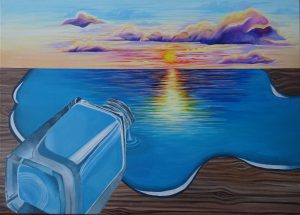BOUQUILLARD, J. (2007) Hokusai’s Mount Fuji, 2nd Edition, New York: Abrams.
This book explores Hokusai’s famous series ‘Thirty-six Views of Mount Fuji’ and how this transformed the art of Japanese print of the 19th century. Hokusai combined traditional Japanese and Chinese techniques with Western perspective to create magnificent and unprecedented landscapes. This book was originally written by Jocelyn Bouquillard in French, and was translated to English by Mark Getlein. It consists of a single narrative and presents a total of 46 plates of Mount Fuji- believed to be the finest impressions of Hokusai’s collection. There is a commentary written for each one, as well as an explanation of why Mount Fuji was considered so sacred, as it was known to hold the secret of immortality. Bouquillard demonstrates how Hokusai depicted Mount Fuji from an endless variety of viewpoints, as well as at different times of the day, different seasons and different weather conditions. For example, the print ‘Thunderstorm beneath the Summit’ portrays the sacred mountain during a storm. Bouquillard (2007, p.18) goes on to describe it: “Squalls, downpour, thunder, and lightning unleash their power at the mountain’s darkened base.” This strongly juxtaposes with another one of his prints ‘Mount Fuji Seen from Goten-yama at Shinagawa on the Tokaido Road’, which depicts “a beautiful spring day…and flowering cherry trees”, as Bouquillard (2007, p.101) describes it. The difference in atmosphere of the two prints is reflected in the colours used too. It can clearly be seen how Hokusai’s work inspired many Impressionists, as the theme of the effect of changing atmosphere and lighting is also seen in many Impressionists’ work. Hokusai presented close ups off Mount Fuji, but he mostly depicted it rising behind a scene of people, such as farmers and artisans doing their daily routines and tasks. This book highlights that by combining the pure landscape of Mount Fuji with human presence in many of his prints, Hokusai represented the harmony between humans and nature, which is a main characteristic of Shintoist belief and gives us an insight to Japanese Culture.

